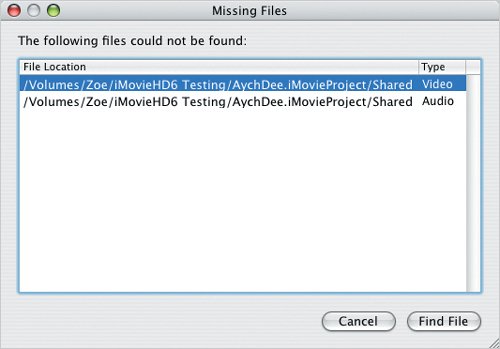| If iDVD is currently running because you shared a movie from iMovie, you don't need to open, create, or save your projectit's all done for you. If you just launched iDVD independently, you can create a new project or open an existing project from the File menu; doing so closes the current project (only one project can be open at a time). The iDVD project file The iDVD project file by default appears in your Documents folder (within your Home folder), and ends in the extension ".dvdproj". Like iMovie, iDVD stores all of its related files in the project file itself, which is a package. Tips  | Many of the newest Mac models sport SuperDrives that burn dual-layer DVD media, which can store up to 8.5 GB of data and hold around three hours of video footage. Make sure you have plenty of free hard disk space availableat least 10 to 20 GB. Storing the project file in the Documents folder may be fine for casual use, but an iDVD project may not fit on your startup disk. While traveling, I move the project file to another partition of my PowerBook's hard disk, or offload everything to a speedy external FireWire drive. If you do move your iDVD project, make sure it can still locate your original iMovie project and its media files. If iDVD gets confused, it warns you with a dialog (Figure 19.1). Select a file from the list and click Find File if the file is actually available somewhere else, or click Cancel to proceed. You can still work on the project if you cancel, but you'll get a broken link warning if you play any of the footage. Figure 19.1. If iDVD cannot locate the media files used in your project, it displays this dialog. 
|
Switch Between NTSC and PAL Choose Project Info from the Project menu, and change the Video Mode setting at any time. Also, in iDVD's preferences you'll find a Video Mode setting in the Projects area that applies to new projects. |
DVD Disc Speeds DVD discs are marked as being 1x, 2x, 4x, or 8x speed. The SuperDrive that comes in the current iMac, for example, writes data at 8x speed, which means the laser that carves into the disc's surface is fast enough to keep up with a faster-spinning disc. The SuperDrive in the MacBook, on the other hand, writes data at 4x speed. All recent SuperDrives can write to higher-speed media, even if they're not 4x- or 8x-speed drives, at 1x or 2x speed. |
Using iDVD on Non-SuperDrive Macs You can run iDVD 6 on a Mac that does not include a SuperDrive, then archive your project or save it to a disc image for burning on another computer (see Chapter 23). |
|
